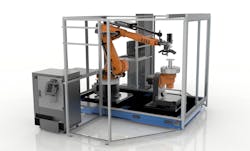Whether it’s referred to as 3D printing or additive manufacturing, the technologies used in this manufacturing method have been moving quickly beyond their initial applications in prototyping. Plenty of evidence about this transition has been published recently (see links to more Automation World articles highlighting this evolution below) and more announcements keep coming.
The latest news involves a partnership between Stratasys and Siemens that involves the integration of Siemens motion control hardware and PLM software into the Stratasys Multi-Axis Robotic Composite 3D Demonstrator. According to Stratasys, the 3D Demonstrator represents “a hybrid approach to automated composite part production.” Rather than using only the traditional additive manufacturing print-by-layer process, the robotic demonstrator integrates subtractive manufacturing, FDM (fused deposition modeling), inline inspection and verification and product finishing. Stratasys says this approach allows them to apply additive manufacturing processes to “high value composite structures, making them lighter than ever before.”
Both Siemens and Stratasys note that, though additive manufacturing technology has made great strides over the past years, additional steps are required for it to take its place in volume production environments and become as commonplace as CNC. To compete with CNC, Stratasys and Siemens say additive manufacturing must “deliver robust, repeatable and reliable operational performance with predictable properties across a broad portfolio of materials that are certifiable for specific applications and that are driven by a seamless, digital integration from design to production.”
The 3D Demonstrator, which synchronizes FDM additive manufacturing with complex multi-axis motion, is one of the first steps the companies are taking together to address the challenges of putting additive manufacturing on par with CNC. Initial target industries for the 3D Demonstrator include the automotive, aerospace and tooling industries.
Speaking about the 3D Demonstrator’s capabilities, Richard Garrity, president of Stratasys Americas, says that, by combining FDM with robotic tool changing capabilities, it is now possible to make 3D printed components measured in feet rather than inches.
Production of a component using the 3D Demonstrator begins with Siemens’ NX software. Designers use the software to create parts to be produced on the system. They can also simulate and evaluate the design for manufacturability and generate and send all the manufacturing instructions for part production from NX to the 3D Demonstrator robot. NX connects the design and manufacturing process on the 3D Demonstrator by communicating directly to the robot’s manufacturing operations management systems.
Motion control for the 3D Demonstrator is handled by Siemens’ Sinumerik 840D sl CNC. The integration with Stratasys’ extrusion control technologies to execute manufacturing instructions from NX CAM reportedly results in a high degree of freedom for robotic FDM extrusion.
The ultimate aim of the partnership between Siemens and Stratasys is to “help their customers adopt a new manufacturing mindset that they believe will result in better products produced more economically and delivered more efficiently,” said Zvi Feuer, senior vice president of manufacturing engineering software, Siemens PLM Software. “We are committed to the industrialization of additive manufacturing with all of its unique advantages, including complex part geometries, on-demand production and mass customization. This relationship helps set the course for continued innovation and leadership through the tight integration of our product lines and collaboration on comprehensive additive manufacturing solutions.”
The video below shows the Stratasys Multi-Axis Robotic Composite 3D Demonstrator in action and features comments from users at Ford Motor Co. and Boeing.
Recent Automation World 3D printing/additive manufacturing coverage:
Leaders relevant to this article:


